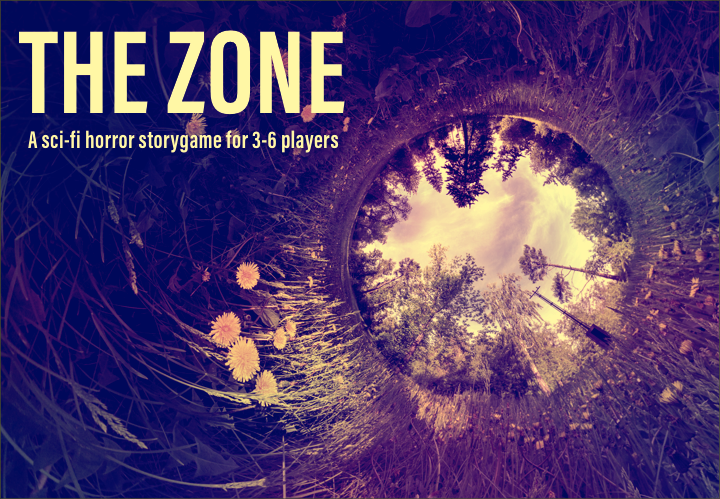
THE ZONE is a tabletop storytelling game about a doomed expedition into a mysterious quarantine zone, whose center will grant one survivor their deepest wish. A game of magical realism, mutant weirdness, & sublime self-destruction.
All we know is that everything that gets close is mutated beyond recognition, and that the deeper you go, the more of your humanity you lose. None of those sent in have made it back out… until now.
Gameplay
3-6 players choose characters, co-create the locations, and together tell the story of their journey to the center of THE ZONE. Over 2-3 hours you will describe the wonders and horrors found inside, the grisly (or sublime) fates of all but one of your characters, and the ultimate nature of THE ZONE itself.
This is a GM-less storytelling game, so players collaboratively share the load, with a philosophy of “play to lose” where “winning” means telling the best tragic story.
The vibe is hanging out with friends around a campfire, trying to creep each other out with the darkest and most uncanny stories you can think of…
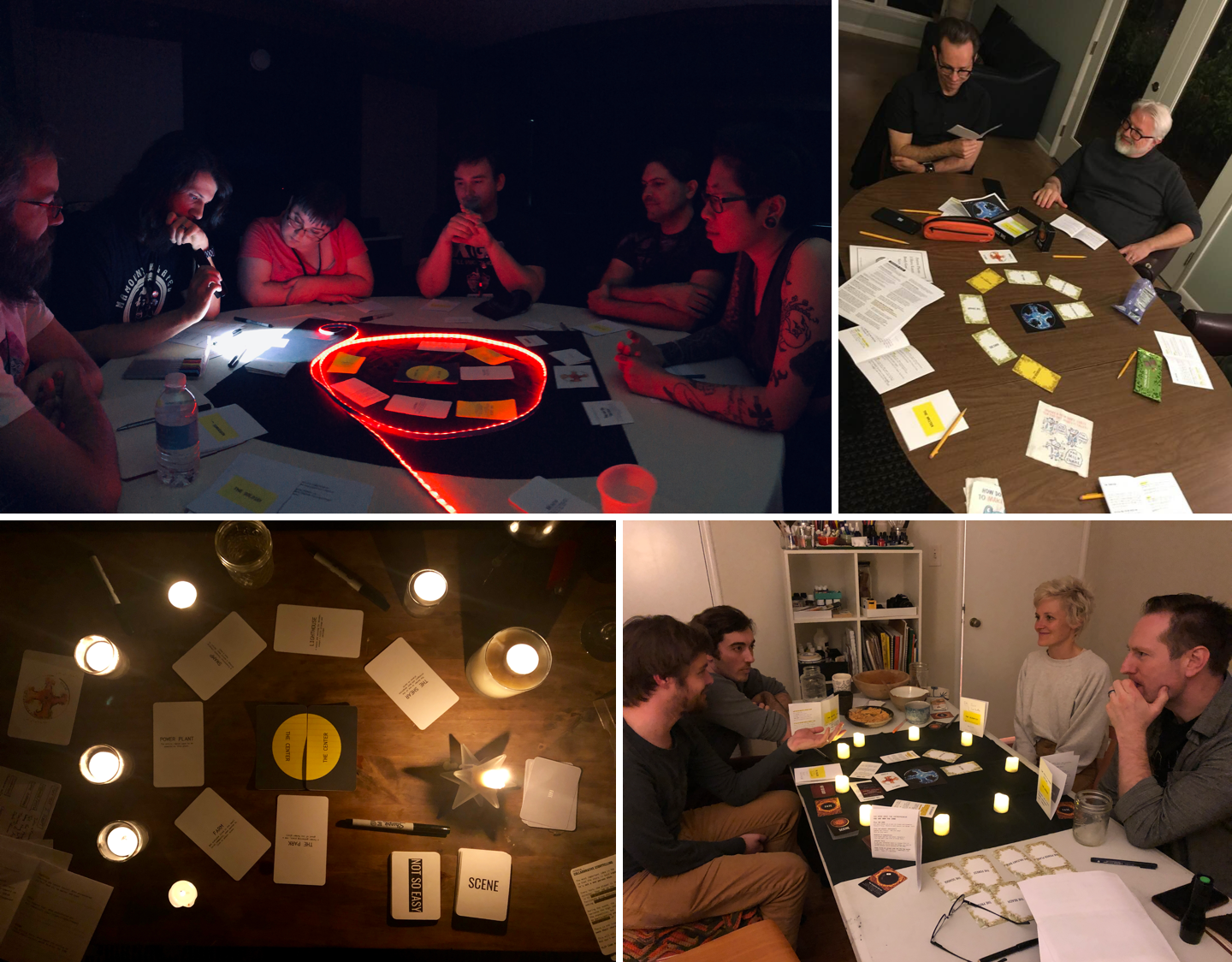
What the game is like to play
- The journey into THE ZONE is represented by a spiral of Location cards
- Players take turns narrating the story, with 50+ Scene card as prompts
- Players each have a character with a strong Motivation, Phobia, and Temptation, whose Fate is decided at the start (when they die, players become THE ZONE)
- There are no stats or dice rolls. When a player wants to do something difficult, they resolve it by drawing a “Not So Easy” card (a hack of Archipelago)
- At the end, the surviving player will ask The Center to grant their wish… and players will together create the way this doesn’t go quite as planned
These aspects make the game lighter weight than most roleplaying games, while still providing enough structure to make storytelling approachable for anyone.
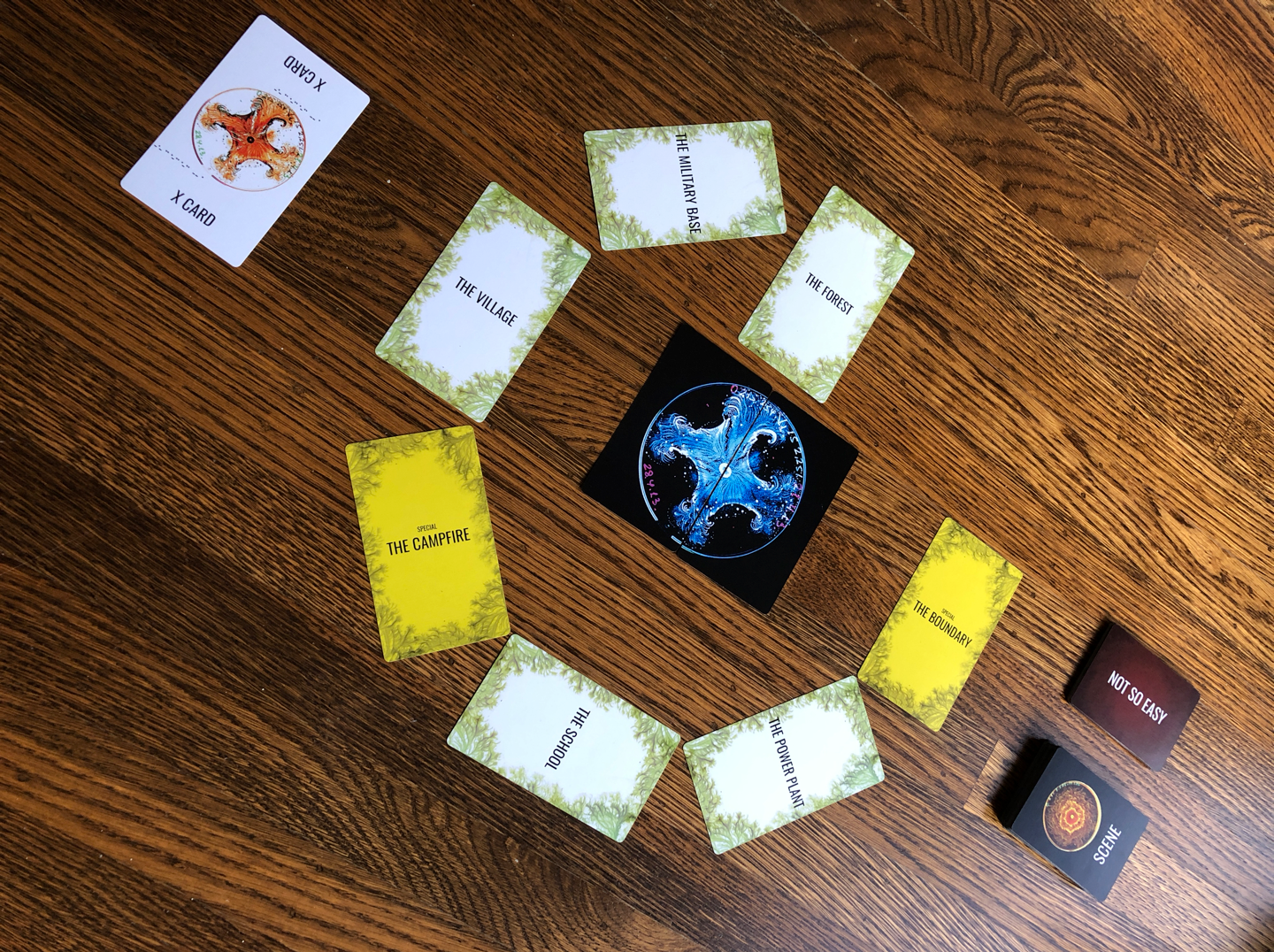
Themes
- Campfire stories
- Adventurous journeys
- Uncanny things beyond human comprehension
- Self-destruction, mutation, and loss of humanity
- Playing to lose
Inspiration
THE ZONE is inspired by classic books and movies like Jeff VanderMeer’s novel Annihilation, Arkady and Boris Strugatsky’s novel Roadside Picnic, Andrei Tarkovsky’s film Stalker, the S.T.A.L.K.E.R. series of games, H.P. Lovecraft’s short story “The Color Out Of Space”, and every horror game where a group of unlucky souls go into a place they can’t possibly understand and end up picked off one by one. 😉
THE ZONE will be Kickstarted sometime in 2019
Sign up for the mailing list to be the first to know!
Blog posts about THE ZONE
Kickstarter rewards are shipping soon!
Hello friends!
It’s been a long time since I updated this blog, largely because I’ve been keeping most of my updating to the Kickstarter Updates. (Some part of me had deep aspirations to mirror them on the blog—perhaps I’ll do that someday!)
But either way, stay tuned because The Zone is going to be available here very soon!
And if you want to follow along, here are links to all the updates so far:
2023
- Oct 26 · #18: Final reminder - Orders locked in 48 hours
- Oct 15 · #17: Big Update - Orders will be locked & charged *Sat October 28th*
- Sep 9 · #16: August Update - Final proof approved & manufacturing is underway
- Aug 5 · #15: July Update - Print & Play is out!
- Jul 6 · #14: June Update - We are on the rails
- Jun 13 · #13: May Update — 99.999%
- May 11 · #12: April Update — On track + white samples!
- Apr 8 · #11: March Update — New ship date
- Mar 2 · #10: February Update · Pre-production kicks off
- Feb 4 · #9: January Update — BackerKit time!
2022
- Dec 26 · #8: December Update
- Nov 26 · #7: Into the nitty gritty we go!
- Nov 7 · #6: Pre-orders are now open!
- Nov 1 · #5: WE DID IT!! 🎉🥳
- Oct 24 · #4: [UPGRADE UNLOCKED] Reusable Glowsticks + In-studio actual play on Wednesday!
- Oct 16: #3: $210k! Nanuk case mocks! Solo play!
- Oct 7 · #2: $160,000 in 10 days! The ball is ROLLING
- Sep 29· #1: OVER 600% FUNDED! Thank you my friends!
Kind of emotional to see them all in sequence like this. And it’s just the beginning.
Read MoreJanuary Update: so much to report!
So much to report! This is the year The Zone comes to the atomic world, so the last weeks have been about gearing everything up for the Kickstarter—a scary prospect in these logistically challenging times. The brain-exploder is that you’re only as on-time as the longest task, so I’ve been focusing on the shiny things like art (especially cover art!) and getting ahead of promo.
When will it launch? Sometime between the end of March and April.
With that in mind, I have a question for you: what are your favorite rpg podcasts, actual plays, newsletters (etc) that should feature The Zone during the campaign?
(Or if you are one of them—hi! 👋😃—want to feature The Zone sometime end of March / April?)
Let me know via Twitter or email!
Other than that, this time we’ve got:
- 🤿 The Maelstrom! An acquatic mutation for The Zone
- 📺 Streaming myself making most of the mod in under an hour
- 🔀 Twists on The Zone
- 🤖🎨 AI generated art experiments for the printed cards
- ❤️ Story Synth grants + The Tiny Hexcrawl for First Dates
If you know someone else who might dig all this, feel free to forward this blog—as I get closer to crowdfunding I’ll need all your help to spread the word :)
🤿 The Maelstrom

The first Zone mod is now read for you to play!
MAELSTROM is a subaquatic twist where you explore a mysterious deep sea city that shouldn’t exist, your oxygen at the mercy of a strange force. It’s inspired by The Deep House and The Abyss, and let’s face it also by that one amazing scene from Waterworld (yes I KNOW)…

It’s also a stress test of the whole UX of authoring and distributing mods, which I want it to feel as easy as possible. Let me know what you think!
📺 Livestream making of Maelstrom
This was really fun! I wanted to show how little time it takes to make a mod so I livestreamed myself customizing the basics, choosing the color theme, and tweaking the prompts.
It shouldn’t take dozens of hours to customize The Zone. It could be 20 mins before your session adding some in-jokes you know your group will love, or picking particular kinds of cards that will match a theme.
Collaborative storytelling isn’t just about the players at the table, it’s also a collaboration players and the game itself. Once it’s in your hands all that matters is what it sparks in your world, not what I intended. I want it to be as easy as possible for you to express those sparks back into the game.
Reminder that if you want to make your own mods all the instructions are here: guide.thezonerpg.com/guide/mods/quickstart.html
🔀 Two page twists on The Zone

One thing I’ve learned making Maelstrom is how little needs to change to completely transform the game. It makes sense—the mechanics are explicitly designed to grow a story like a fractal and the Location, Scene, and Not So Easy cards are specifically written to work with a wide range of topics.
When I first started making The Zone I wanted it to be about a specific feeling, not any particular story. The feeling of being dragged headlong by a current that’s as much the lighthouse of your obsessions as it is the pressure wave of your phobias. A lot of different narratives can fit into that structure.
That’s why the print game game will come with a gaggle of 6-10 twists in the back of the book, including MAELSTROM of course.
 I expect these to be either 2 page spreads with just a new briefing and some guidance on how to change the decks, and probably also a few 4 page spreads to make space for a generator table (or two) and awesome art. These mostly won’t be written by me—I want to hire (paid of course) from the community to make these storyseeds as weird and diverse as possible.
I expect these to be either 2 page spreads with just a new briefing and some guidance on how to change the decks, and probably also a few 4 page spreads to make space for a generator table (or two) and awesome art. These mostly won’t be written by me—I want to hire (paid of course) from the community to make these storyseeds as weird and diverse as possible.
If you’d be interested in being commissioned to write one, hit me up!
🤖🎨 Experiments with AI generated art
One of the toughest design challenges in The Zone is that I want the visuals to set a tone, but they shouldn’t be so specific that they cognitively railroad players into particular stories by accident. That’s why the current location cards only have abstract patterns, to focus on the words.
I want the book and box artwork to have stunning commissioned pieces from artists, but with that consideration the game materials themselves have so far been more of a raw graphic design conundrum. The Zone is supposed to be truly alien. Something that can’t be put into human words or concepts.
That’s why I’ve been experimenting with the weird world of AI guided art because it’s literally like talking with something from beyond the human world. It’s like guiding two aliens in conversation with each other. One (DIFFUSION) is an eldritch lovecraftian horror able to take literal noise and turn it into an image. After many steps, it starts to look like… something, depending on how it’s guided. The other alien (CLIP) is a weird creature whose entire understanding of the world is 400 million text/image pairs taken from across the entire internet. DIFFUSION makes the images, and CLIP guides it in alien teamwork, kinda-but-not-really-like a game of telephone pictionary.
Guiding these aliens towards the right kind of imagery feels different than any artistic process I’ve ever done, much fuzzier and less deterministic.
 The results are incredibly variable but exactly the kind of thing I hope to evoke: non-human surrealism that somehow seems to mean three things at once (which is convenient because each card has 3 totally different prompts on it).
The results are incredibly variable but exactly the kind of thing I hope to evoke: non-human surrealism that somehow seems to mean three things at once (which is convenient because each card has 3 totally different prompts on it).
 It seems to know certain styles more than others. For example, somewhere in the 400 million images CLIP learned from was probably some of the work of amazing Polish surrealist painter Zdzisław Beksiński. So I could ask it to use that as an influence. Here’s what I got by entering the text from the Location cards for “The Mall”, “The Hospital”, “The Military Base”, and “The Swamp”.
It seems to know certain styles more than others. For example, somewhere in the 400 million images CLIP learned from was probably some of the work of amazing Polish surrealist painter Zdzisław Beksiński. So I could ask it to use that as an influence. Here’s what I got by entering the text from the Location cards for “The Mall”, “The Hospital”, “The Military Base”, and “The Swamp”.

The results are interesting. There’s a lot of experimenting to do—getting a good image requires generating several hundred weird ones, which takes hours and even days. But I’m very excited about where this is going to go, and it’s a blast to dance with this weird alien process. In the next few weeks I’ll try for a test print with the holographic foil finish. Can’t wait to see what it will look like!

❤️ Story Synth grants + tiny games for first dates!
On a totally different note, I collaborated with Randy Lubin to redesign his amazing and completely free online play & playtesting platform Story Synth in time for the super-exciting announcement of $30,000 in grants for marginalized creators to make small storytelling games.
It’s such a cool project, and great to see another way for the community to get some support. Check it out here!
Finally, to celebrate I ported my tiny little booklet of storygames for first dates & small talk to Story Synth’s very very cute hexcrawl format (not a part of the grant). Everything you need to play it is in this thread on Twitter 🙌❤️

And that about wraps it up! If you made it to the end, congrats. If you want to follow the journey and you’re not on it already do join the mailing list!
What did you think of all this? What are you excited about? I love hearing what you think—hit me up on Twitter or via email.
I appreciate y’all very much.
—Raph
Read MoreWant to make your own Zone? (you beta you can)
So much has happened since the launch of The Zone! Hundreds of you have entered The Zone, many more than once. I love to be in the Discord when an expedition ends and a few shaken survivors come in to share their stories, beautiful and horrifying in new ways each time.
A confession
It’s wild that the launch was 6 months ago, but can’t believe that’s also when I last sent an update! Each time I wanted to send an email I’d end up writing something far too long, feel anxious about cluttering your inboxes, delete it, then Tweet a lot. Going forwards I’ll send short updates like this one a little more frequently. You’ve been my biggest supporters—I want to let you in on what’s going on!
And there’s so much goodness I haven’t had a chance to share:
- There have been a whole bunch of actual plays by the wonderful folks at Plus One Exp, 3rd Floor Wars, TPKRoleplay, League of Raconteur Explorers, and others. These are gorgeous productions; LORE even made a custom opening title sequence that gave me chills! I’ve collected those that are available on YouTube here!
- My interview for Jeremy Gage’s Draw Your Dice podcast is up! We talk about the design process and thinking behind The Zone, and have lots of brain explosions about UX in general. (Side point, Jeremy is one of the loveliest humans & educators in TTRPGs right now and if you’re not following his Patreon/Twitter/Podcast you’re missing out!)
- I shipped a full-on digital reference to the game, full of goodies including tips for facilitation, frequently asked questions, and even an interactive tool you can use to make sure your session takes as long as you actually want it to!
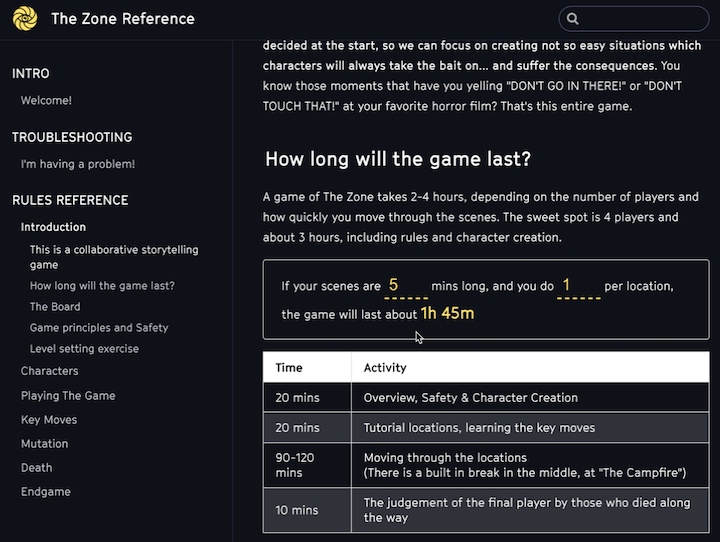
- But most importantly: you can now mod The Zone!
Modding The Zone is now in beta
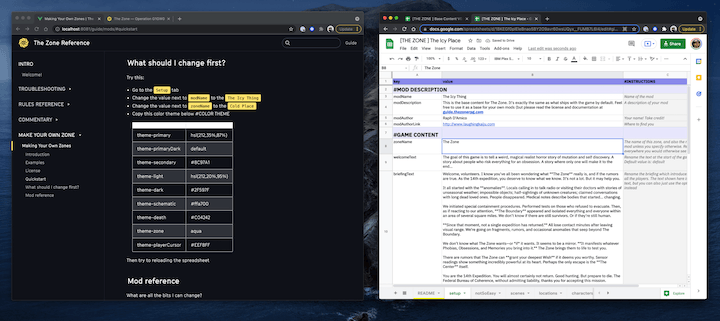
The title says it all. Inspired by the deliciousness of StorySynth.org (Randy Lubin’s creation where you can develop a whole game in a spreadsheet) I’ve opened up all the content of The Zone so you can remix it, make it your own, then use the engine at Play.TheZoneRpg.com to run it with all the same multiplayer fancyness as the original.
In just a few minutes, you can:
- Color theme your game
- Change (pretty much) all the images in the game
- Change all the key text
- Make your own Scenes, Not So Easy Cards, and Locations
- Make your own Character archetypes
- There’s more too, you’ll just have to come check it out ;)
This took major rearchitecting and rewriting of pretty much every part of the game, but it’s been so worth it just imagining the kinds of things that I know y’all will make with it—and I’ve got a few things I’ll be cooking up too. (Let me know if you’d like me to write about that process)

But I need your help!
These modding tools are only useful if they’re usable. I’m working on the documentation and examples, but would dig your feedback even in its beta state. Especially:
- Does it give you what you need to get started?
- What’s missing?
- What are you excited to make (or see made)?
Check it out: https://guide.thezonerpg.com/guide/mods/
Got questions or just want to see it in action? I’ll be doing a livestream next Sunday at 1pm PST on The Zone’s Discord.
Phew! So much to say but I’ll stop here for now and just say that I’m so excited to see what weird new Zones the community will create.
Let’s get weird, y’all ;)
Read MoreThe Zone is OUT NOW!
It’s time! Come play the new weird world of The Zone.
☢️ #TheZoneRpg is OUT NOW! ☢️
— Raph D'Amico (@raphdamico) April 18, 2021
3 years, 100+ playtesters, a physical version & epic rebuild into a zero-prep free virtual tabletop
Play to lose new-weird-horror where all will mutate, & only ONE will survive!
My magical-horror-friends, come play!https://t.co/ryXNlb7Dqb
Launch Event
We had a fantastic launch event in Discord, with great turnout! (By the way, you can join the Discord server too to meet other Zone fans and get work in progress updates as I keep improving the game!)
Five expeditions launched at the same time and brought back deeply weird and wonderful stories.

Did you check out the stream? It gave me chills…

The survivors made their wishes. The Zone (or, I should say, the players who had become one with it) judged those wishes.
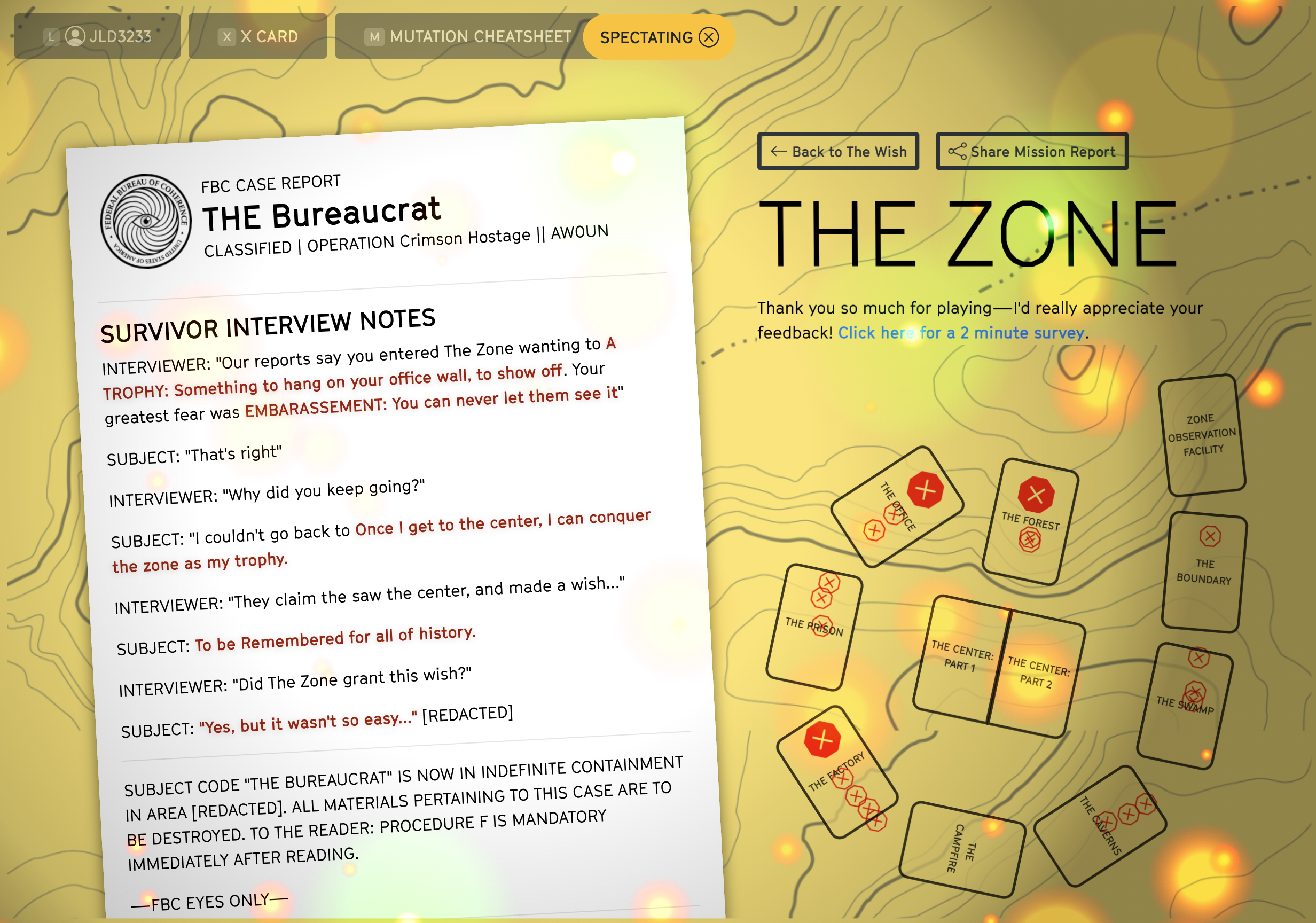
Nobody comes out of The Zone unscathed ;)
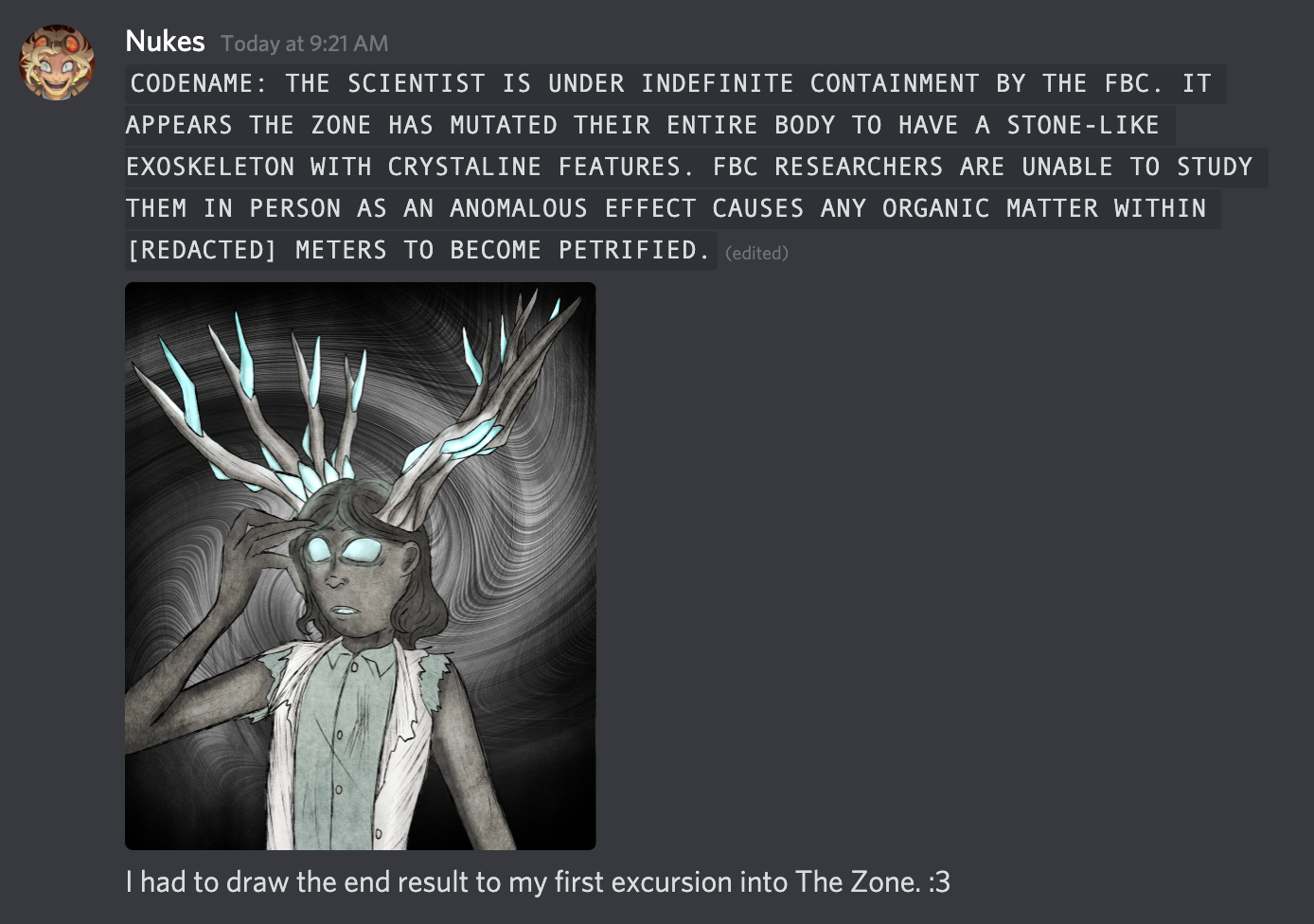
It was my first time running a virtual event like this. I learned a lot about setting up Discord, event agendas, reminder emails, and the like. I also went a little off the deep end and wrote a bot to make it as easy as possible to find and join games. I couldn’t have done it without the community management genius of Eliot Miller, who I credit with the entire structure of the event.
Come play!
I’m so excited to finally have The Zone be out there and playable by all. I’ve worked hard to create a GM-less experience that is truly zero prep, that runs itself and teaches you all the rules as you go. I hope this can be a gateway to weird magical realist storytelling for you and your friends, and that you’ll have countless weird and wonderful expeditions!
Just an exceptional game. My fav play experience from big bad con 2019 now converted for remote play in a custom interface that teaches everyone as you go! Like a jackbox room where you mutate and tell a gorgeous horrifying tale! And it’s freaking FREE!! You gotta try it out https://t.co/cdF0RQRFM0
— World Champ Game Co. (@WCgameco) April 19, 2021
Start a game at play.thezonerpg.com!
I hope you’ll share your stories with me via email, Twitter, or in the Discord. The journey is just beginning ☣️
Read MoreThe Zone RPG is launching to Early Access on April 17, 4pm PST!
After 3 years, 100+ playtesters (thank you!), an entirely realized physical version, and then an epic rebuild into a digital experience, The Zone is just about ready for your doomed expeditions.
Join me on Apr 17 at 4pm PST for our free Discord launch event, where you’ll be the first to enter The Zone. Bring your friends to play, join pickup games with other fans, or just meet other folks who love magical realist horror, rpgs, and weird storytelling.
I’m so grateful to all of you for supporting this project! Whether you ran a playtest or just signed up for this list out of curiosity - every little bit has helped make this game a reality. Thank you, my friends! 🙏
I hope you’ll be able to make it — can’t wait to hear the strange stories you’ll bring back from your Zones!
Read More☢️ IT'S TIME!☢️#TheZoneRpg is launching in TWO WEEKS!
— Raph D'Amico (@raphdamico) April 3, 2021
[Apr 17, 4pm PST]
3 years, 100+ playtesters (THANK YOU!), a physical version & epic rebuild into a free virtual tabletop, ready for your doomed expeditions!
My magical-horror-friends, come play!https://t.co/9Np2NJ0uHf
The Zone is coming to your s̷c̷r̷e̷a̷m̷ screen
In the midst of all this devastation, I have an exciting announcement. It’s taking me a while to figure out a plan, but TL;DR: I will be bringing The Zone to a digital release more appropriate for these pandemic times. Physical release will still happen, but when it feels right.
And I’ll be need you to help me playtest! Ping me on Twitter or email if you’d like to be one of the first to try it.
What happened
Aaaaah, February. I had just torn open the latest playpacks of the mostly complete game and was ready to figure out who to send them to. Some incredible art was coming through (more on that later!) An April or May Kickstarter sounded just right. I’d even finally had a chance to play my own Golden Cobra game, whose key mechanic is gentle physical touch (though with social distancing on the horizon, we’d already switched that to a distanced gesture).
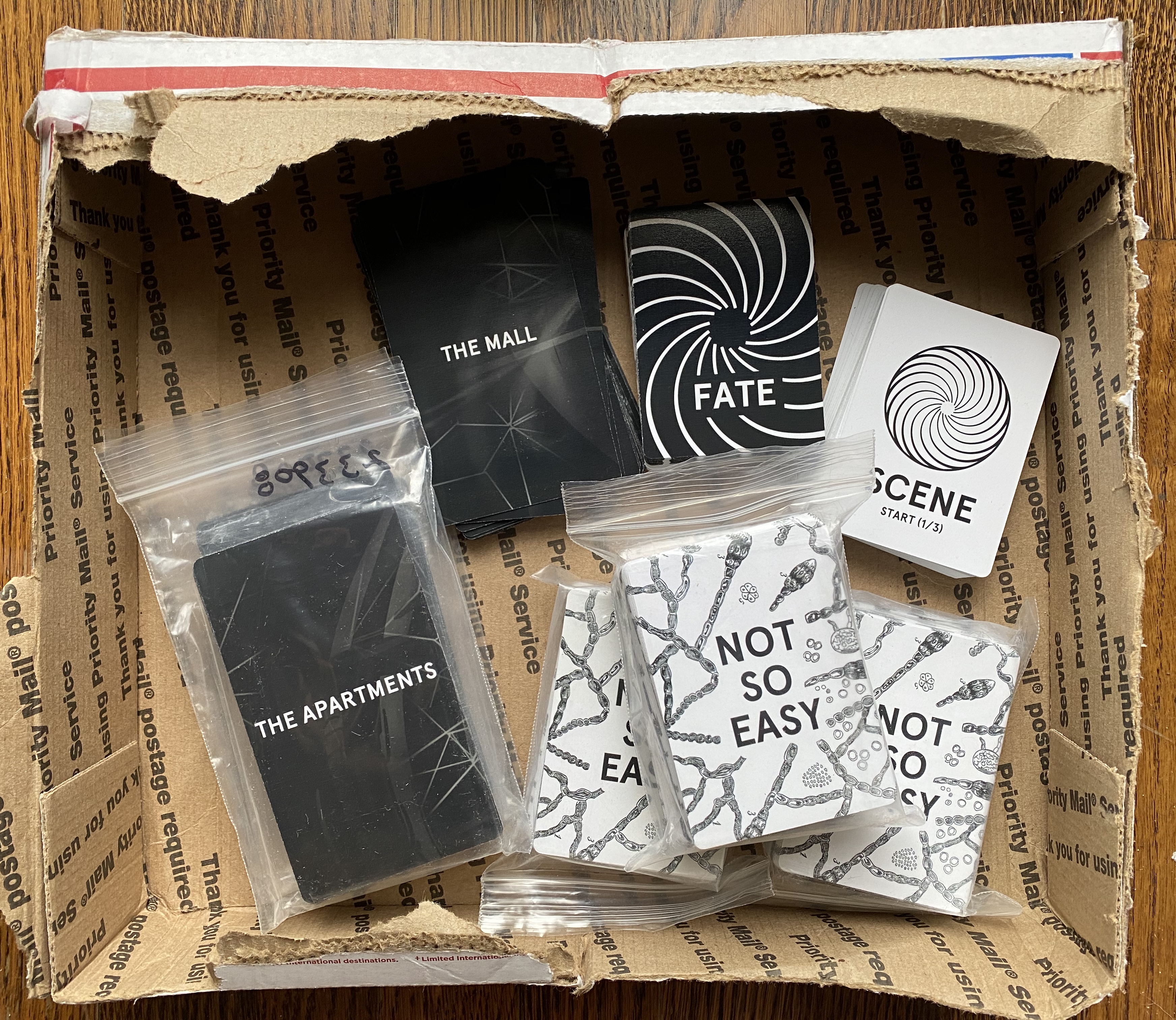
And then it all happened. You know—the thing.
Ugh. It was no longer right to gather friends in an enclosed space to play the release candidate. I stopped planning playtests. I tried to keep working on the layout—and got pretty far telling myself I’d just get it finished so it was “ready to go” when the time came—but instructions aren’t just a thing you write. They are the crystallization of the conversation that gets a game going, and without playtests I had no feedback loop to that conversation. Making progress felt like pushing on a string.
I stalled out.
Making art is important—especially in a moment like this—but it just doesn’t feel that way when you’re in this moment. Things that gave you comfort suddenly feel exhausting. Having made something affirms that you still have a little bit of control, it helps you carve a bit of an eye into the storm, but actually doing the making becomes gut wrenchingly hard.
Many of you reading this are makers too, how have you dealt with this?
The Zone goes digital (first)
So I started messing around with Roll20 and Tabletopia (which I’d already experimented by running a great playtest with the wonderful Amber Autumn & friends).
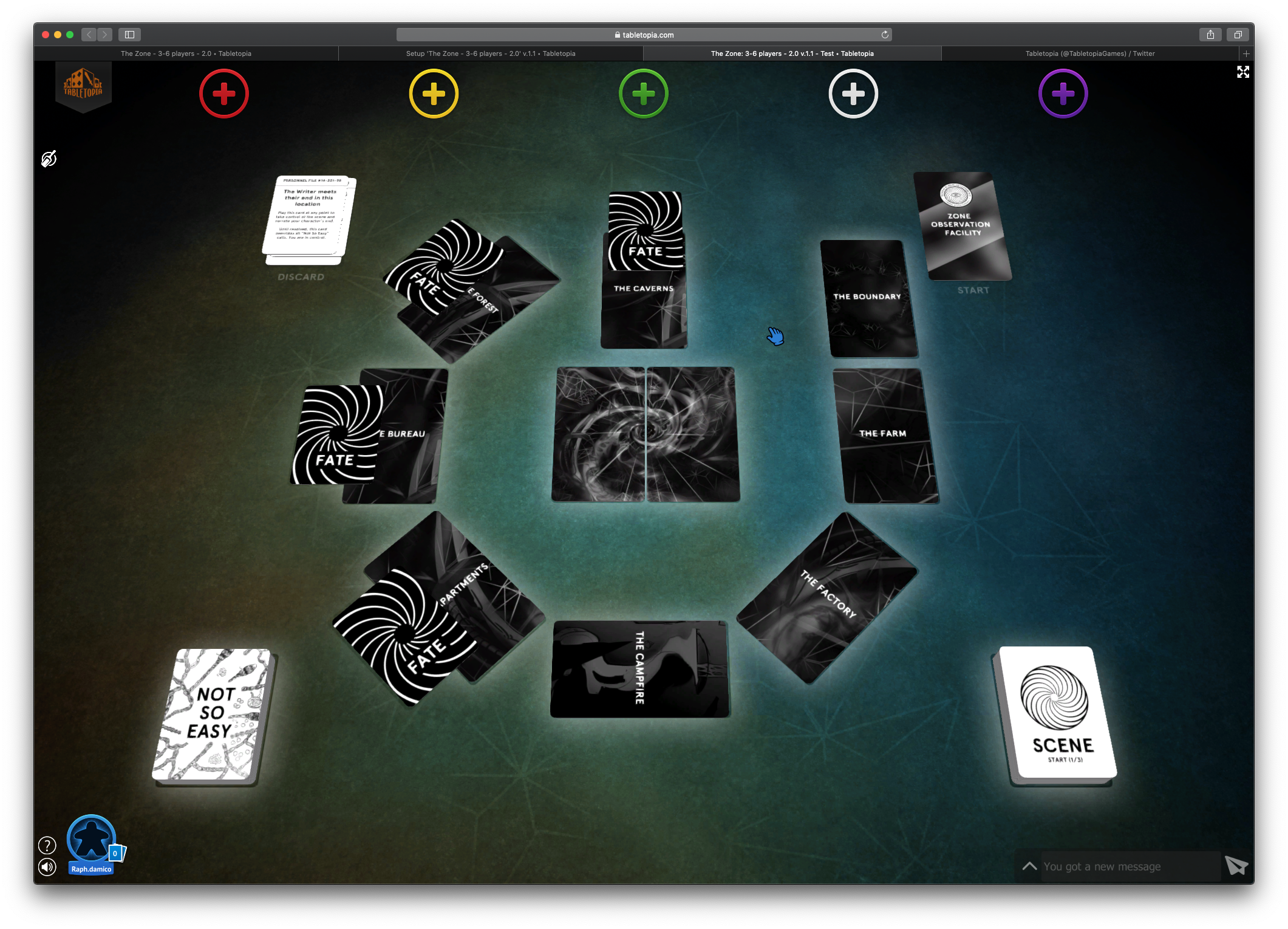
But I felt a few things were missing in just literally translating the table to a virtual space.
A huge part of The Zone is the atmosphere. It must be played in the dark. With glowsticks. I wanted that.
And I wanted it to be accessible. Roll20 is incredibly powerful and also incredibly fiddly—I’m not sure I need all that power for a GM-less game. And shrinking down all the cards to screen size doesn’t make the best use of that form factor.
Finally, I want to guide my players. I want it to be the easiest couple of hours of spooky storytelling since, well…

(Disclaimer—The Zone will not include a VHS player.)
Check it out
So, it’s time to get making. I’ve been having a lot of fun this week prototyping.
The first thing I set up was placing all the game elements, using Figma as a level editor. This was easy using the Figma API, and saved me a massive amount of time getting everything placed just right (a pain point I’ve felt many times trying to develop on the web with just graphics libraries but no editors). I expect it to help even more when I start layering more artwork into the game!
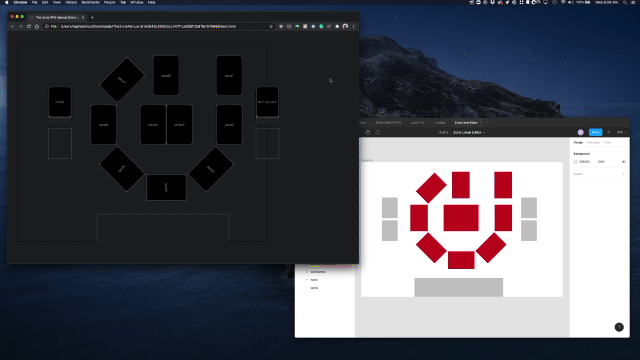
Then I worked on drag & drop, hand management, getting all the basic mechanics of a card game to work. I wanted to make card movement super juicy! So yes, I got distracted for a while “benchmarking” Hearthstone, Slay The Spire, Monster Train…

Oh, and last bit! Atmosphere through Digital Glowsticks™️
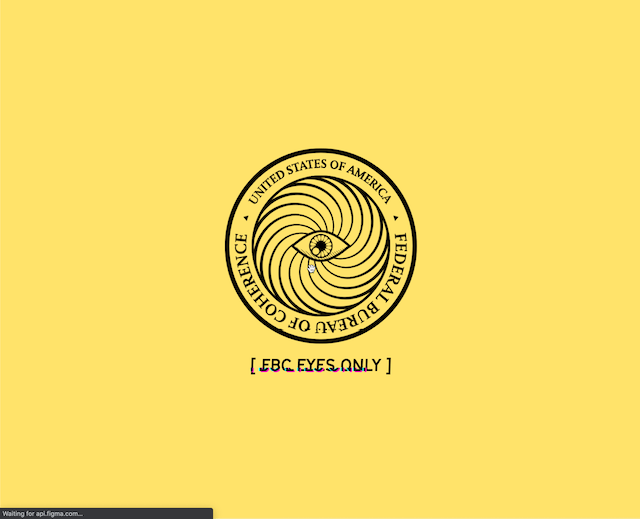
Most importantly, this gives me a path forward and motivation to keep building the darn thing. I still can’t wait to get the physical version into everyone’s hands, but this is a perfect challenge in the meantime. It’s already looking promising!
Coming next: multiplayer, and the very interesting challenge of adapting rules, handouts, & character sheets!
Read More2019.52 | 2020.1: End of year recap
Hello friends,
It’s been quite a year! A challenging year, in fact, featuring burnout, chronic pain, healing, deep friendship, and quite a few games! I released several, won an award, and am pretty psyched to say that The Zone is almost ready! On to the update.
The Zone (ghostly noises 👻)
Before we go any further, check out the gorgeous cover artwork by Veronique Meignaud.

I’ll talk about this more in a future blog post, but I’ll just say here that I wanted a piece that would capture the metaphorical Hadean descent into annihilation of the game. Tremendously grateful to have had had a chance to work with her!
The game itself has been enormously refined in the last year, with quite a few in-person and blind playtests. It’s just about feature complete.
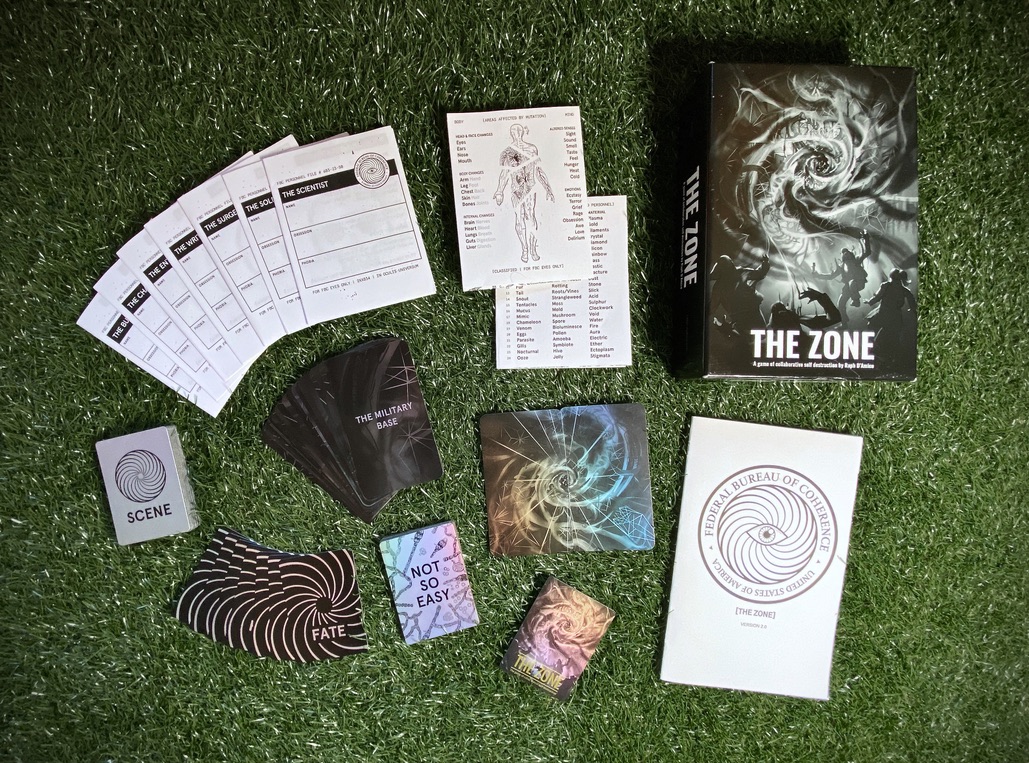
Most fun was bringing it to Big Bad Con with a couple of dozen large sized glowsticks, which I’ve decided are the absolutely definitive way to play!

I’m starting to hone in on the layout and details. For example, check out the rainbow shimmer I’m hoping to have for the card finish. When you hold these choices I want you to feel the color out of space ;)
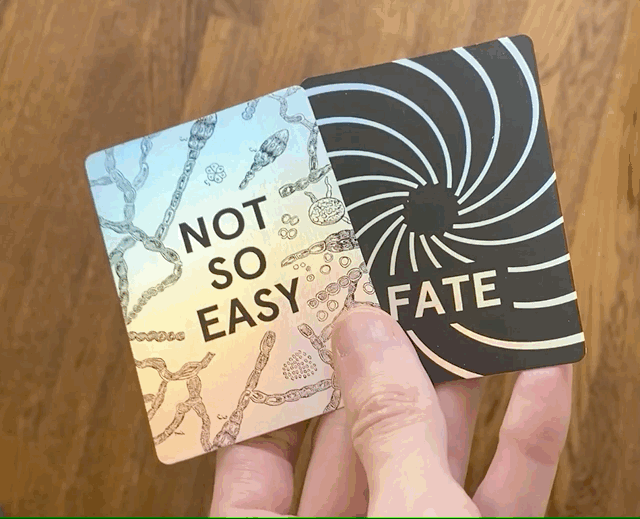
The plan is to have it in your hands sometime this year. Stay tuned for more announcements!
The Laughing Kaiju Weekly
Game design is as much about mechanics, UX, and figuring out the right weight of paper stock as it is about social science, psychology, and anthropology.
I started writing The Laughing Kaiju Weekly back in November so I’d have a weekly space to explore these topics and amplify other voices in the community. It’s been wide ranging, just like the design process. Previous topics have included:
- Social mechanics in online games
- Games that make you feel more lovey and connected to others
- Agency in games and theme parks (and life)
If that sounds like something you’d like to receive in your email, sign up here.
Golden Cobra!
I won two Golden Cobra awards this year for my game: “They Say You Should Talk To Your Plants”, a weird meditation on how living things, even those as immobile as plants, help you stay alive too. I’m really proud of it!

Dungeon Court
A hack of Jason Morningstar’s Ghost Court, a party game featuring fantasy monsters and heroes pleading their cases, which me and Randy Lubin designed for Roguelike Celebration. The players brought the room to tears of laughter. Watch it here!
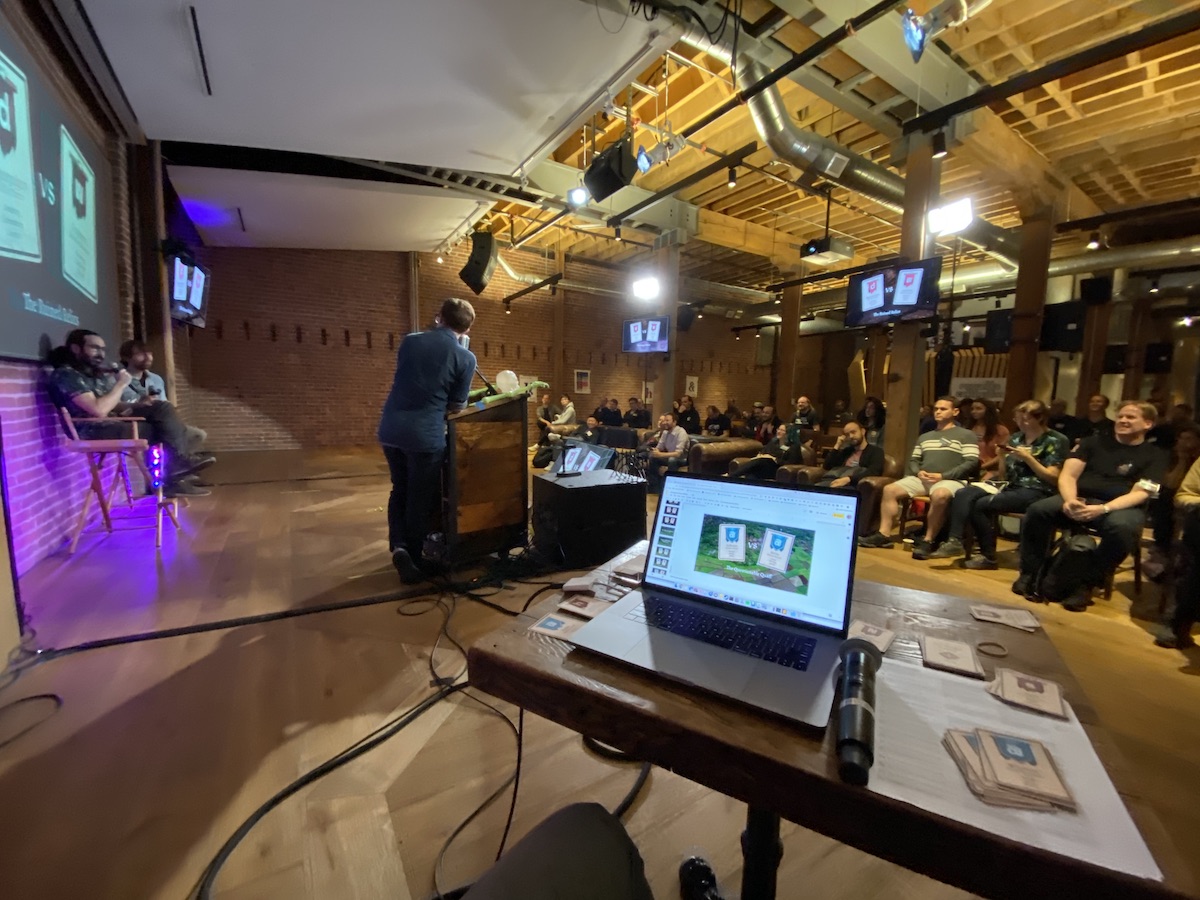
Other stuff
- I entered the Sad Mech Jam with a game of ancestral mechs called: “Your Ancestors Are Watching”. It was indeed sad.
- I made a wallet sized book of tiny storygames to play on first dates.
- Prototyped quite a few other games. I’m particularly excited about this idea of a backward storytelling and insurance inspection (yep) game. Stay tuned
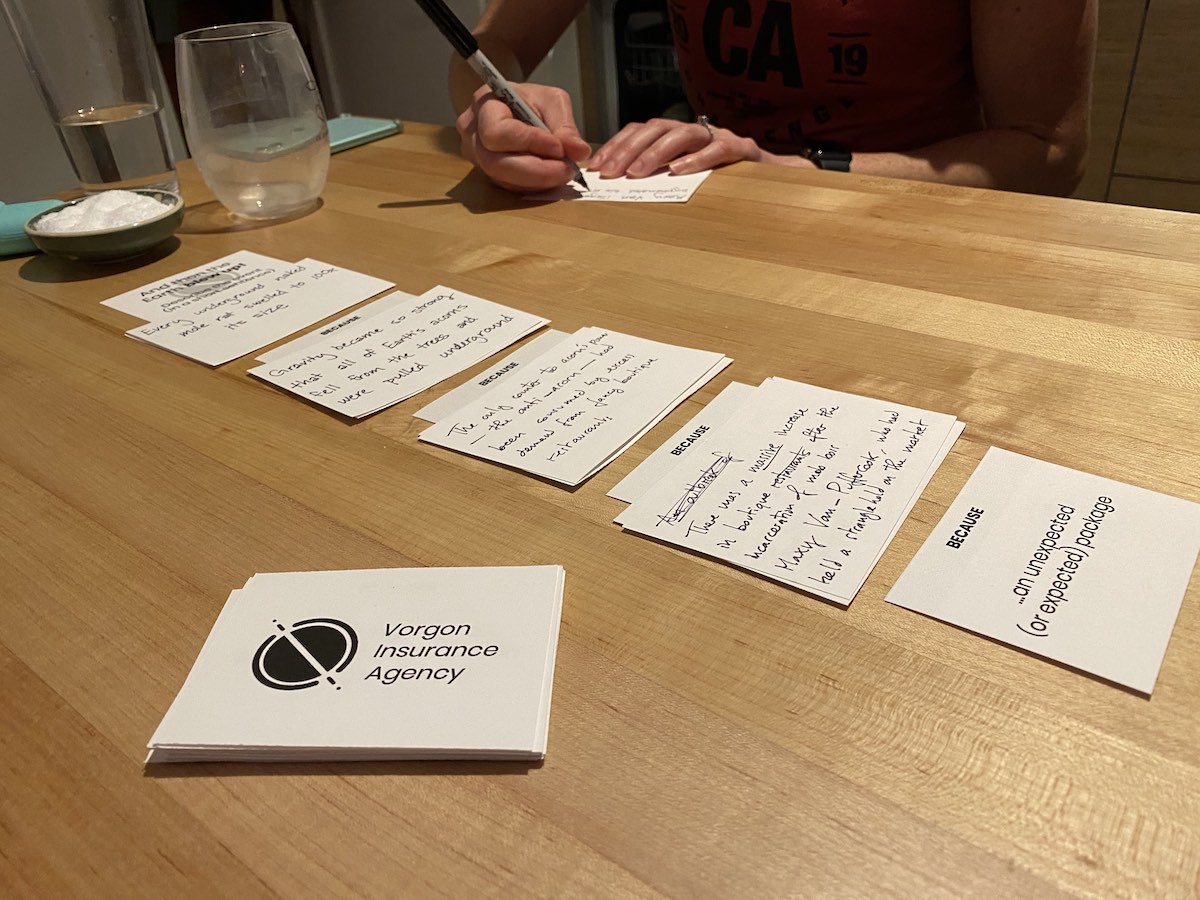
- Worked with Autumn Haynes on a logo for the eponymous Laughing Kaiju and she knocked it out of the park (you can see it right at the top of this post.) I love this little guy and Autumn was a pleasure to work with!
Looking into 2020
Last year was extremely challenging for me, but also a great teacher. Health and chronic pain remind you what’s truly important: friendship, support, play, love, the taste of a shared meal, caring for your body. It’s no surprise to me that I made a game about self-care; or that my most beloved project is a game about self-destruction (ego death?).
It’s terribly easy to ignore these things until it’s too late, and if there’s one thing I’ve learned is that love and connection are not an academic pursuit. Which is why I’ll absolutely be doing a detailed academic investigation of them over the next year in both game design and the weekly update 😅
Ha.
Seriously, though. The founding principle of everything I do—and the reason you should join me on this journey if this is something you dig too—is that games are the playground of human connection, in all its forms, deep, shallow, with hundreds of people, or just two.
I’ll say it again: games are the playground of human connection. Game design is the laboratory—or perhaps the garden—of the very same thing.
Everything I do ultimately comes back to this. I hope to live by it. And I also hope to create by it in 2020.
Hope you’ll come along for the ride with me 🙏
Read MoreA very atmospheric playtest, and some musical goodies!
I ran another playtest of The Zone last night, staged astonishingly well by my friend nickpunt@, and the amazing jeeyonshin@ live tweeted the entire thing.
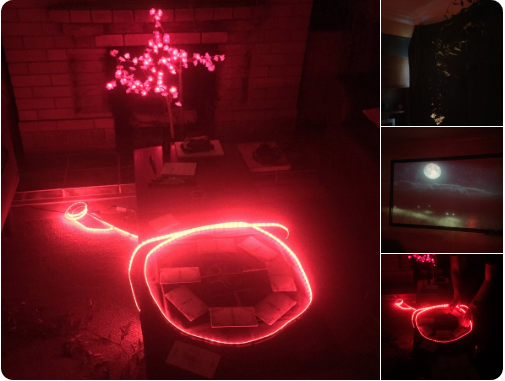
She captured precisely the eerie wonder and horror of the game. Gives me chills!
I’m sitting down to playtest @raphdamico’s #TheZoneRPG with friends and Nick pulled out all the stops as game host: pic.twitter.com/fa93qwWbj3
— Jeeyon Shim (@jeeyonshim) May 27, 2019
A taste:
The third expedition supposedly found a stone — palm sized, unremarkable to look at — that cures anyone who held it of anything that was wrong inside. Of course, no one came back from that expedition or the right that came after it, so it’s just a rumor. pic.twitter.com/Ojbk26P2Uf
— Jeeyon Shim (@jeeyonshim) May 27, 2019
The beauty.
The longer we stay the more miracles we see. Light motes hunt in lethal packs. The lapis blue leaves gather together and form a new arm for The Scientist. Trails clear themselves before us. The more miracles we witness, the further I feel from God.#TheZoneRPG
— Jeeyon Shim (@jeeyonshim) May 27, 2019
The horror.
The Soldier rests his hand on the elk’s forehead. The light motes pulse in tandem with his heartbeat. The leaves on the floor swirl. Blood drips up from the creature’s wounds as the Chaplain’s voice resonates through him:
— Jeeyon Shim (@jeeyonshim) May 27, 2019
“My child. There is no forgiveness here.”#TheZoneRPG
Looking for the perfect soundtrack to listen to it by? Here’s the atmospheric playlist we played by which I’m just going to now call the official soundtrack of The Zone. It was amazing to experience the synchronicity of our storytelling and the music, each influencing and enhancing the other. (Thanks Nick & Dana for putting it together!)
Read MoreHow should I talk about horror?
I made a somewhat maniacal map of the influences on THE ZONE, as an exercise to see if I can talk about the game without mentioning the word “horror”.

Four key themes came out of the exercise:
- SELF DESTRUCTION. The loss of humanity that comes from hubris, ambition, and enthusiastically joining with forces you don’t understand. This is about players “playing to lose”, putting their characters in harm’s way at every opportunity, to rise… and then fall spectacularly. This is the primary theme of the game. The other three support and enhance it.
- MYSTERIOUS JOURNEY. An epic trip into uncharted territory, full of forbidden sights most people will never see—or which are the last thing they experience before the journey consumes then. Expeditions move inexorably forward, never looking back.
- MAGICAL REALISM. The accurate physical detail of the real world, inflected with the laws of poetry, magic, and dream logic. There is more sublime psychedelia the deeper you go, but it’s in constant contrast with hyper-real sensory details.
- BIOLOGICAL WEIRDNESS. Bodies, fauna, and flora mutating and metamorphosing under the influence of magic, science, or the supernatural. Strange, incomprehensible monsters. In this game, they are external metaphors for character’s inner phobias and temptations.
(And thank you to all who replied to yesterday’s tweet with comments & suggestions!)
But wait, isn’t THE ZONE a horror game?
Now, I loooove horror, and some of my deepest inspiration for the game are Annihilation, but also clear horror classics like Alien, The Thing, or Akira. As a result, I’ve tended to pitch THE ZONE as a “sci-fi horror storytelling game”. This typically elicits one of two reactions:
- _“I loved Annihilation / Stalker /
! I’m so excited to play!”_ - “Not for me—I hate scary movies!”
Good right? The people who will enjoy the game have opted-in, and those who won’t have exited. Self selection achieved—right?
Not so much.
The problem became clear when I’d ask followup questions to those in group two. Did you enjoy Stranger Things? “Yes! Binge watched it with my friends!” The Walking Dead? “God was that first season good.” Scary stories around campfires? “So fun!” From Game of Thrones to Black Mirror, horror themes are woven deeply through the biggest hits in mainstream media, which many (though not all) folks who were self-selecting out had seen and loved.
And no wonder! Horror is thrilling. It may allow us to experience and learn to overcome fear in a safe place. The physical sensations—bone pounding, heart racing arousal—awaken the body and make us feel poised and alert. As Gothic writer Ann Radcliffe puts it, terror “expands the soul and awakens the faculties to a high degree of life”. And that’s just scratching the surface (I could go on about horror vs terror for hours). But that’s a whole other blog post.
But horror is so broad and some of its sub-genres so horrific that people’s perception tends to be dominated by memories of “torture porn” movies like “Hostel” and “Saw”, slashers like “Friday The 13th”, or the gruesome and transgressive experience of “The Exorcist”. These powerful reference points would drown out the themes and reference I’m trying to elicit.
Check out this map of horror genres courtesy of the folks at horrorscreen.com. When I say “sci-fi horror”, I’m asking people to navigate to a tiny spot in the giant map full of gore. No wonder they get lost.
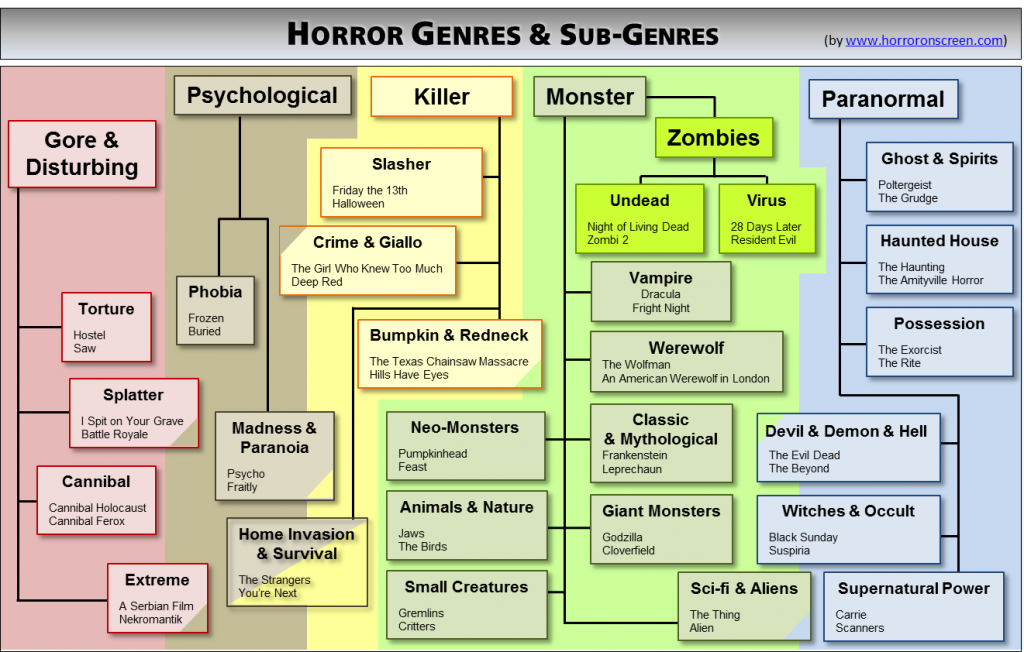
The golden rule: Empower players to create their own level of horror
THE ZONE uses horror in a very specific way: to explore the larger theme of our human hubris & self-destruction in the face of the things we cannot understand.
There is a particular kind of horror that inspired the creation and aesthetic of the game, but that is subservient to an ironclad principle I’m following: that players should be empowered to create their own horror. There are deeper reasons for that principle (nothing is scarier than what’s already in your mind) but it also supports diversity of experience. The last thing I want people opting out because they have slightly different reference points than the Annihilation “scream-bear”.
Because of that, the game is designed explicitly to allow each table to imbue the game with their own interpretation and level of horror.
For example:
- Content variety: Each location card is designed to have three variants: the gruesome, the uncanny, and the magical
- Safety tools: The safety tools include the X-Card, but I also encourage players to do a light version of “lines & veils”. In some games, this has meant all gore ending up completely offscreen
- Positive opt-ins: Safety tools tell you what not to do, but I also suggest players have a positive discussion of the horror themes they want to include.
- In-game opt-ins: the key escalation mechanic “Something’s not right” empowers players to decide when and how to escalate the horror
Put that all together, and you have an extraordinary variability in the level of horror, from constant blood-soaked-body-mashing to magical fairytales.
Guess what—even Charlie and the Chocolate Factory can be derived from the basic principles of THE ZONE. (Side point, go watch this right. now. I’ll wait.)
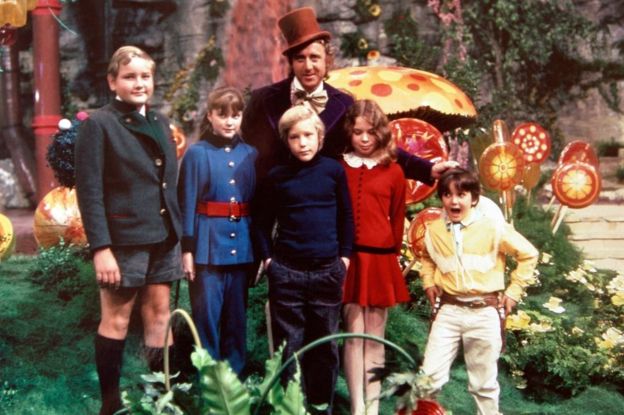
But does it check out against the principles?
Self-Destruction? ✅
Mysterious Journey? ✅
Magical Realism? ✅
Biological Weirdness? I mean… come ooooon! ✅✅✅✅✅
 This seems like a good time to reference Seanan McGuire’s awesome spectrum of alternate worlds from her book “Every Heart A Doorway” (it’s sooo good):
This seems like a good time to reference Seanan McGuire’s awesome spectrum of alternate worlds from her book “Every Heart A Doorway” (it’s sooo good):
Here in the so-called “real world” you have north, south, east, and west, right? Those don’t work for the most of the portal worlds we’ve been able to catalog. So we use other words. Nonsense, Logic, Wickedness, and Virtue. There are smaller sub-directions, little branches, but those four are the big ones. Most worlds are either high Nonsense OR high Logic, and then they have some degree of Wickedness or Virtue built into their foundations from there. A surprising number of Nonsense worlds are Virtuous. It’s like they can’t work up the attention span necessary for anything more vicious than a little mild naughtiness.
Tor.com created a giant map, of those lands, including Oz, Wonderland, and Narnia. My hope is that, similar to the variety of this map, players will create an incredibly variety of exclusion zones, from the wicked and violent world to the virtuous and beautiful!
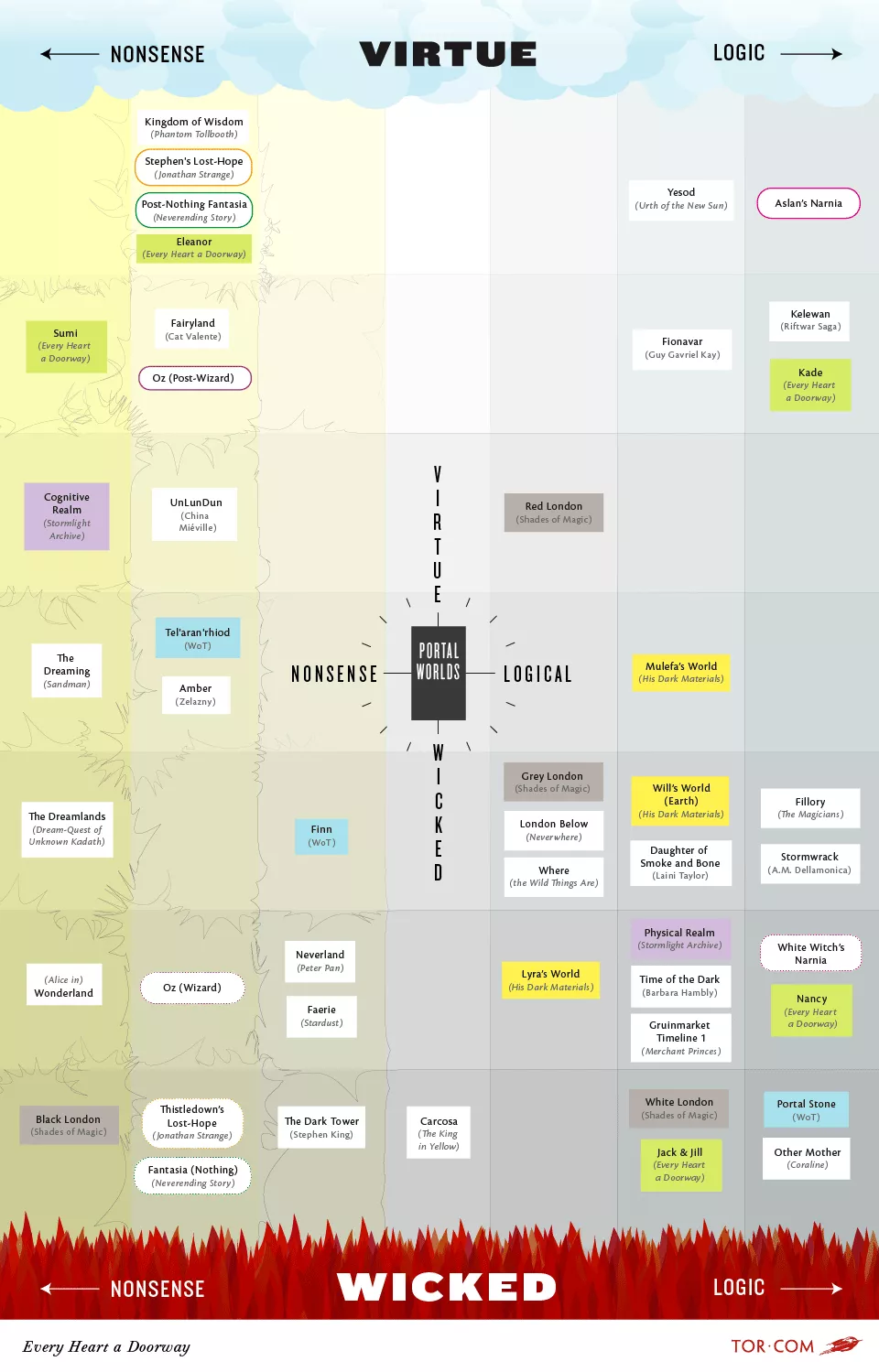
And that’s why I’ll maybe de-emphasize “horror” in the top-line description of the game, and maybe just describe it as a “storygame about a doomed expedition into a mysterious quarantine zone whose center will grant one survivor’s deepest wish.”
What do you think? Let me know on Twitter or via email!
Read MoreMetatopia 2018
My first time at Metatopia and I loved it! I’m still sleepless, feeling the con crash hard. I played some amazing games with staggering emotional range (particular credit to Alex White’s “A Cool and Lonely Courage”, which ended with 20 seconds of silence to process at the end. Thank god for a whimsical game of Fiasco In A Box immediately after).
Other highlights: Chad Wolf’s wild diversity of ideas (in one LARP I was a fairy light, blinking in and out of existence, in the other we manipulated Ursula LeGuin’s “dreamer who dreamt the world”!); Stephen Dewey’s “Gather: Children of the Evertree” (deeply elegant conversational mechanics and diegetic teaching of the rules), Tim Hutching’s “Operation Linebacker” (a script made of real Vietnam cockpit recordings that shockingly subverted our expectations).
Thank you Avie & Vinny for an amazing time, and—what a segue!—for getting me the perfect space for three playtests of THE ZONE. It doesn’t look like much… but it was beige perfection. Oh “Headquarters B”, I will never forget thee.

And most of all thank you so so so much to playtesters Anne, Whitney, Allen, Robin, Elias, Brian, Eleanor, Sean, Korey (x2!), Michael, Jenna, Mike, Nina! Your feedback was an amazing gift and your stories were perfectly, teeth-clenchingly, shiver-my-spinefully, delightfully… horrifying. Squeeeee.
What did I learn?
I had hoped to test out player death mechanics (a crucial part THE ZONE and why the “Director” role is about scene instead of character control)—how it felt to have your character die, and whether it had the desired escalation as players shifted roles from embodying characters to being THE ZONE.
Instead, I found myself focusing almost entirely on the instructional design of the game.
The game doesn’t start when it starts
There’s an adjacent framework from the terrifying world of gnarly startup growth tactics called Psych’d, that puts this rather well:
- Every element
on the pagein the instruction adds or subtracts emotional energy- Inspiring
usersplayers is as important as reducing friction
Or to put it differently, how might I avoid this?
Explanation Of Board Game Rules Peppered With Reassurances That It Will Be Fun https://t.co/OiZwLlOKxj pic.twitter.com/GGsqFh7F97
— The Onion (@TheOnion) November 4, 2018
How might I maximize the emotional energy of my players during the necessary 30ish minutes of instruction? And which parts of the instruction actually correlate with a better game?
My first playtest was a perfect stress test: people were sleepless, stressed from prepping their own games for playtests. By the end of my rambly intro, the energy level was gone. We’d spent far too long discussing safety mechanics, trying to internalize rules out of context, and my decision to skip character creation saved time but left people without skin in the game.
A humbling start!
Just before that playtest I’d attended a great panel on horror, moderated by Anne Ratchat, in which an audience member paraphrased the genre as: giving players interesting bad choices”. I had a realization: I had to give players stronger incentives to define their character’s psyches, then create explicit reasons to express their character’s fears out loud so other players could learn and act on them. I want THE ZONE to be an engine for defining and playing with the two sided coin of fear & temptation. Every mechanic should make players complicit in ratcheting both up mercilessly.
(And yes, fear and temptation—horror & love—flipsides of a same coin. Horror isn’t just about removing agency. It can be about getting exactly what you want… at the wrong time.)
I had to focus on the singular goal of the game: to help players safely explore themes of horror and loss of humanity. The entire game world, the intro to the game, and every part of the instruction of the rules should help set the tone. Even the microcopy on the character sheets and the sample Phobias & Temptations were a surprisingly important part of this world building.
In the second playtest, I completely changed the sequencing. A short storyful intro to the world, then character creation. I used the Phobia part of the character creation as a jumping off point for safety mechanics, which worked well, then taught the 3 key moves in a set of short workshopped scenes. 40 minutes! Too long, but it mostly worked. People felt more invested and excited having just created rich characters.
The third playtest was much better. I got a wonderful piece of feedback to take the time not just to level set on safety—what people wanted to avoid—but to also to explicitly discuss what people wanted. I learned a cool thing from a game called Annalise where players are encouraged to explicitly write down on an index card when a cool theme is introduced, so that everyone remembers to build on it.
The world exists to define & amplify the characters
This video essay about Guillermo Del Toro’s monster design sums it up well: the world that gets created around the monsters—or in this case the players—should exist to mirror, amplify, and twist the knife in their deepest fears. THE ZONE doesn’t exist for pure world building—it’s a foil to the characters.
Very excited for where the game has ended up after Metatopia. My next playtest will be an explicit test of the refined rules and instructional design. My goal: to be able to hand players the materials and have them up and running with only limited influence from me.
Can’t wait until Metatopia 2019!
Epilogue: how to cram a 3 hour game into 90 minutes
- Skip character creation… but only if it’s not integral to empathy in the game. In THE ZONE, you really need it. On the other hand, it did no harm to skip the location setup
- It didn’t matter that we didn’t get to the ending. In fact, ending halfway created a rather nice cliffhanger
- You can shorten the story by switching the depth of the scene. It worked very well to have players do quick epilogues for their characters. The hierarchy here would be LARP —> Acting out conversations —> Rich descriptions with everyone involved —> One player just tells the story —> Quick summary. Nice way to still get to the ending
- Safety is the one thing that I’d never skip, but you can certainly shrink it down, particularly as players will have heard it in a bunch of other games
- It will start 5-10 mins late. Decide on a start time and stick to it
- Don’t rush feedback. Ending with a full 30 minutes to go was about right, with an extra 5 minutes of buffer to give people time to get to their next game
- Know what you want to test! If players are stuck in an area you’re not trying to test, it’s OK to course correct and move things along
- Feedback forms were great! Give them out at the beginning, with pens, so people can jot notes as they go
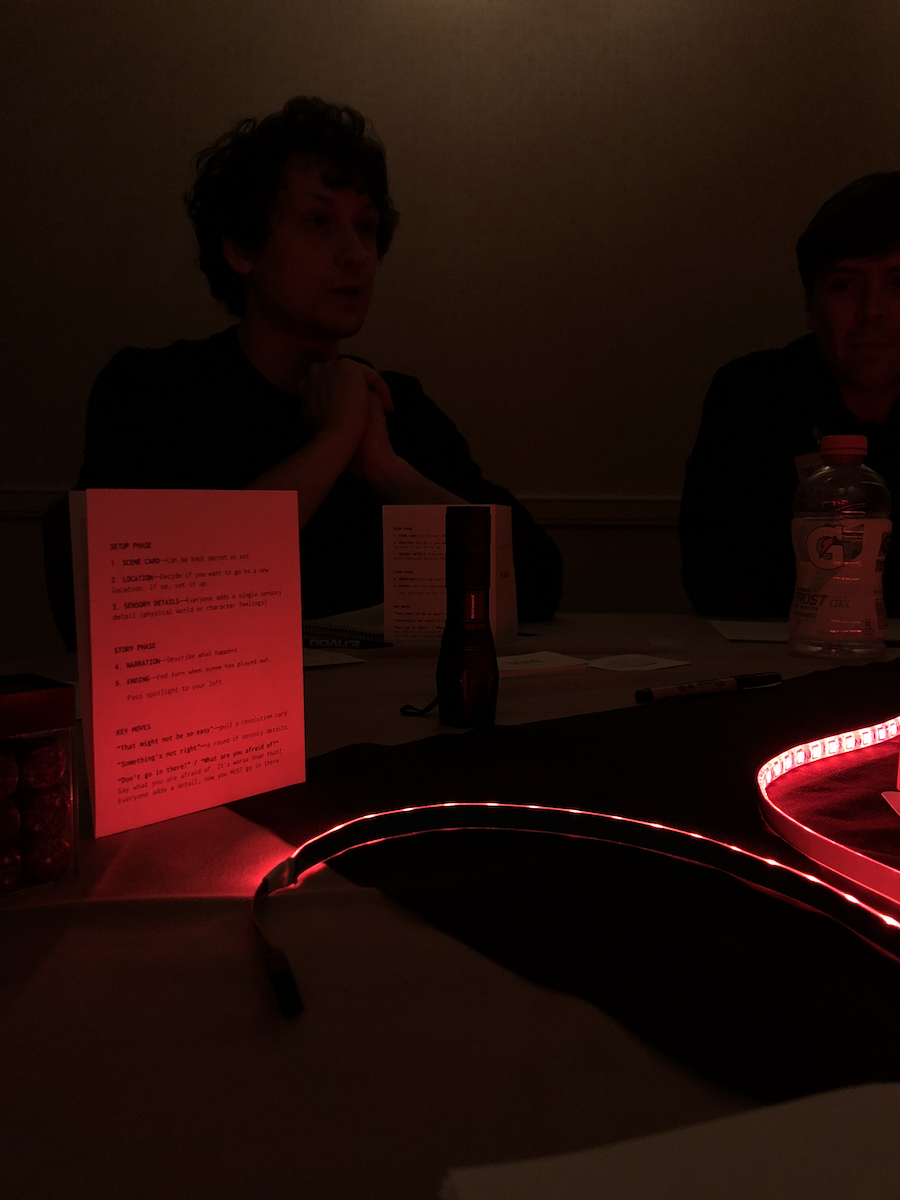
Escalation
This week I focused on a big open question for THE ZONE: pacing & escalation.
My Big Bad Con playtests were the first where I simply facilitated instead of participating, and made me realize that I needed to amplify the escalation mechanics so the game would unlock its potential even without a strong facilitator. Crucial for a GM-less game.
To start, I did a thoroughly incomplete and unscientific survey of some of my favorite storytelling games, and an interesting framework popped out:
Escalation via:
- Individual moves
- Group moves
- Looming pressure
- Triggers
- Role changes
- Schedules
- Reflection & Clarification
- Collision courses
- Staging
- Jenga
Here are some examples of each:
1. Individual moves
Things each individual player can choose to do to escalate the game—”pulling the slot machine” for new content or questions.
They can be completely self-paced content (like putting the mask on in Old Friends, or pressing the button in Juggernaut), “moves” (like “Shiver with fear” in Bluebeard’s Bride), or part of the turn structure itself.
Perhaps my favorite is the gruesome escalation of Beastfucker, which happens entirely through individual players choosing to leave the room to “fuck the beast”. This happens offscreen, and is represented by two prompt questions they must return with answers to. Because of the subject matter, the move itself is an escalation, and the answers just make it so, much, WORSE.
2. Group moves
Moves whole or part of the group can choose to perform to raise the stakes.
An example of this is Welcome Guests, where the hosts—a family of cannibals—can decide at any time to eat one of the guests, but only if two of them agree.
Turns out eating a person does indeed raise the stakes. Check!
Another way to define the stakes is to better define how characters feel about the stakes. Randy Lubin has a lovely way of doing this in his hilarious “Behind The Magic”—interludes where all the characters answer questions in a Big Brother style “confessional” chair.
This is very similar to the practice in long form of improv of “group games”. In the venerable Harold, improvisers start with a freeform group game that expands poetically on the audience suggestion, generating tons of tiny ideas that stimulate later scenes, and a thematic bed that subtly knits them together.
3. Looming pressure a.k.a. “Sword of Damocles”
The top down pressure of a decision weighing ever more heavily on the players as the game goes on. The squirming avoidance is a tension machine; knowing that the decision must be made creates a driving force.
The decision to eat a guest in Welcome Guests is also a perfect example of this. You know it’s coming, which forces each player to come to terms with how they feel about it, and act.
4. Triggers
Specific actions players MUST take in response to a certain situation.
I encountered a brilliant example of this playtesting Luke Crane’s “The Gift” at Big Bad Con. It’s a LARP of stuck up elves and kleptomaniac dwarves, and each side has trigger cards that must be played:
- For the elves: breaking their moral code or seeing another elf threatened
- For the dwarves: whenever they see a shiny thing
In our game, a grief stricken elf drew his ancient golden blade—a true, jewelled marvel—which triggered a dwarf’s MUST HAVE IT “Greed” card, making him a droolingly, drunkenly leap over the table John Woo style to try to take it at all costs, triggering another elf’s “Grief” card when he drew blood in the ensuing tussle… It. Was. A. Bloodbath.
As you can imagine, these triggers can cause wild chain reactions that players cannot stop easily—use with care—but can be a lot of fun!
5. Role changes
Unlocking new abilities, or completely changing a player’s abilities based on circumstances in the game. This category inherently pairs with other escalations, as it needs some kind of triggering condition.
Examples include:
- In Welcome Guests, eaten players return as ghosts. They cannot speak, but they can interact through freezing touch and eye contact
- In Bluebeard’s Bride, an aspect of the Bride can become “Shattered”, removing her ability to control herself with that aspect
- In the Battlestar Galactica board game, several players discover halfway through that they are Cylons
I haven’t seen a storytelling game do this, but something like the Shadow of Mordor Nemesis system could be a very interesting way to do this based on history and rivalries in the game.
6. Schedule
A fixed pacing forced on the players, perhaps literally (as in the fixed length of The Climb), or by having a fixed structure of scenes.
One example from boardgames is in Betrayal at House on the Hill, which begins with group exploration (and creation) of the map, followed by a dramatic midpoint twist where everything becomes horrible and a randomly selected player is revealed as the antagonist.
7. Reflection & Clarification
[Added this section Feb 18, 2019]
In Downfall, every round has an explicit “Reflection”, where the hero “describes the current state of the world” and whether it is ready to collapse, which naturally forces the cracks open by making them clearer.
In Lovecraftesque, every round ends with each player individually theorizing about the true nature of the horror in a mechanic called “Leaping to conclusions”. Making their own interpretation more concrete amplifies their ability to escalate the story in that direction.
8. Collision courses
This is all about initial setup. Two characters want the same thing, need something from each other, hate each other but must work together, or want different things but are in each other’s way.
This is somewhat table stakes for a good character based LARP or storytelling game, but I’ll call out Honor Bound, which explores toxic masculinity through the lens of a duel nobody wants but which is made inevitable by the interpersonal dynamics that the game explicitly sets up.
9. Staging
This final category is fuzzy but incredibly awesome. Certain ways of delivering mechanics are inherently emotional or can make people do crazy things.
- In Old Friends, players summon the dead by putting a mask on and embodying a spirit described on a prompt card. You could easily play the game with just the prompt, but the mask changes things. People do weird things with masks.
- In 10 Candles, you get to burn character sheets! (oh, and the whole game is played by candlelight). In Reflections, the losing samurai, whose body is bisected by their opponents’ blade, tears their character sheet in half at the same time. So cool!
- The loud 30 seconds of electro-mechanical clacking that plays when you press the button to reveal another of Juggernaut’s predictions
10. Jenga
Where did I land?
This is a very rough and incomplete framework, but I found it helpful to go through the mechanics I have in THE ZONE category by category and see if there were opportunities to amp things up. There were indeed!
Individual moves: THE ZONE uses the “Not so easy” mechanic from Archipelago, and explicit scene cards that the spotlight player pulls at the start of their turn.
I added in two more explicit moves that I’m so excited to playtest:
- “Something’s not right here” any players can say this, and the group pauses and each person adds a sensory detail (sight, sound, smell, touch, taste) or character feeling to better define the horror
- “Don’t go in there!”—inspired by “Shiver with fear” in Bluebeard’s Bride: if a player is dilly dallying, anyone else can say “Don’t go in there!”. They must say what they’re afraid of, and then MUST go in there. What’s inside is much worse…
Group moves: THE ZONE explicitly has players add sensory details, which is working realy well.
Looming pressures: This is something I’d like to think more about. Better defining the “Center” might help.
Triggers: Each character has a Phobia & Temptation. These were mostly character development, but I’ve now changed them to be explicit triggers: when a character encounters either of them, they MUST immediately act on them.
Role changes: Yes! When a player dies they become one with THE ZONE. I’ve redesigned the character sheet so you flip it inside out to more dramatically represent that change.
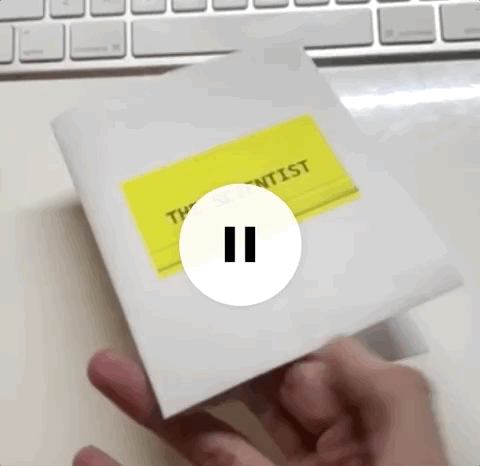
Schedules: Going to try predetermining player’s deaths in more detail
Collision courses: I’ve explicitly dialed this one down after realizing that this game is less about interpersonal conflict than it is about world building.
Staging: I talked about this in the previous blog post. so important!
Jenga: hmmmmmm… HMMMMMMMMM…
Final thoughts
Perhaps the biggest insight for me was that it’s not just about raising the stakes: simply defining the stakes with more specificity can increase their emotional weight and give players more ideas for what to do (this episode of Writing Excuses on “Raising The Stakes” is a great resource here).
I’m left with interesting questions:
- What are the consequences for characters (die, gain or lose abilities, change role, become nemeses?)
- How prescriptive (sequentially scripted content) or open ended (just questions)?
- Divergent (generating new content) or convergent (defining things)?
- Raise the stakes, or simply make them more tangible?
- Escalate the world, or in your characters’ feelings about the world?
- How might an escalation make the stakes more personal to your character?
…and of course: when do I do the Jenga version of THE ZONE?
Read MoreHello World (and Hello Big Bad Con!)
Well this is exciting. After my very first Big Bad Con last weekend, it feels time to gather some sticks, pitch a tent, and kindle a tiny little spot on the internet to talk about storytelling games… including the one I’m actually rather far along in making: THE ZONE.
First of all.
THANK YOU to the wonderful people of Big Bad Con, to everyone who playtested THE ZONE. Stephanie, Aaron, Jonathan, Dani, Peter, Tom, Rick, David & David, Adrian, Chris—you are all master storytellers, lovely humans, and I so appreciated your thoughtful critique and ideas! The game is already better because of you all.
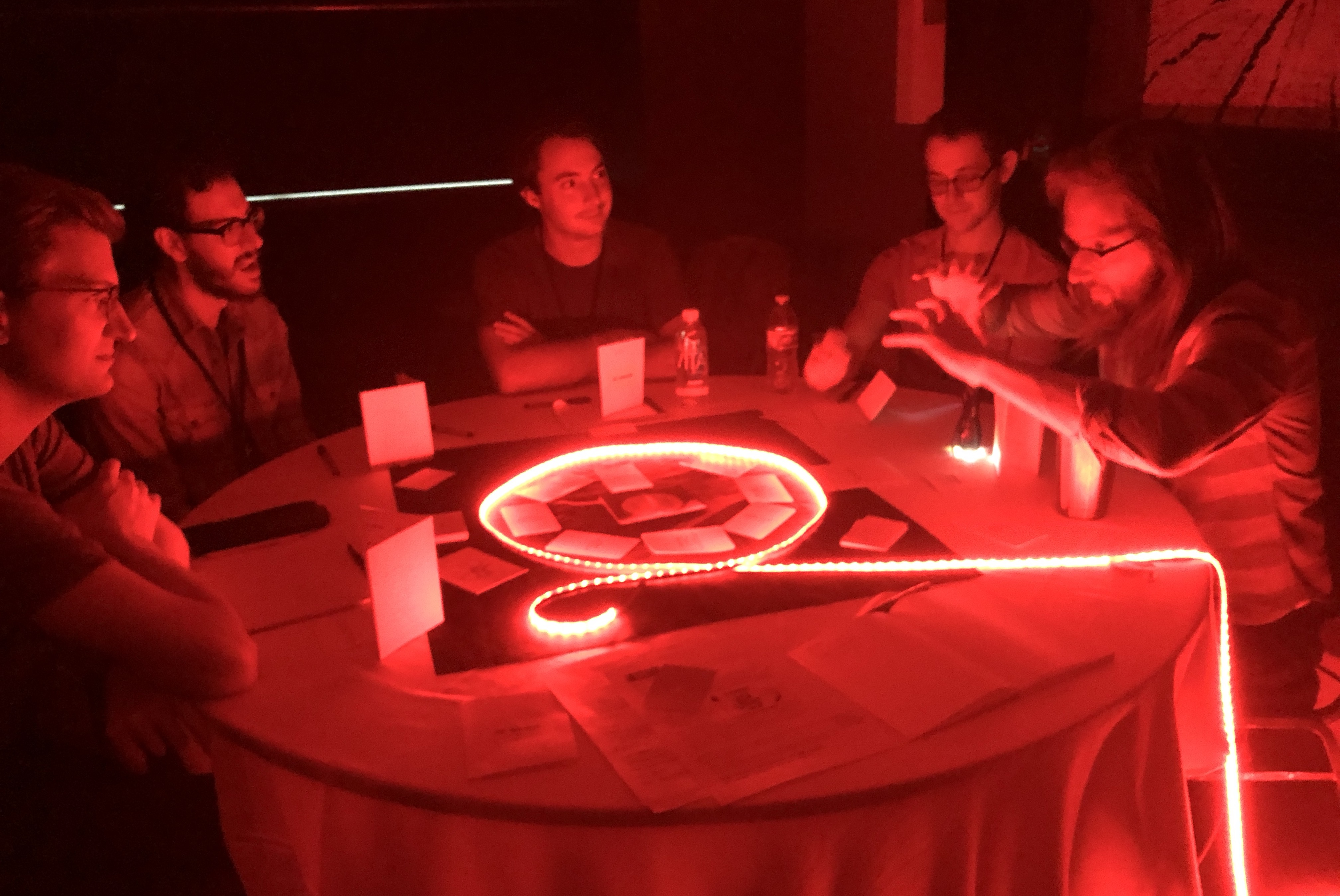
I learned so much, but I’ll focus on one big thing: staging.
I’d underestimated the importance of props in creating the necessary atmosphere, but a few days before BBC I undertook a last minute flurry of semi-random purchasing on Amazon, which led to some very fun experiments:
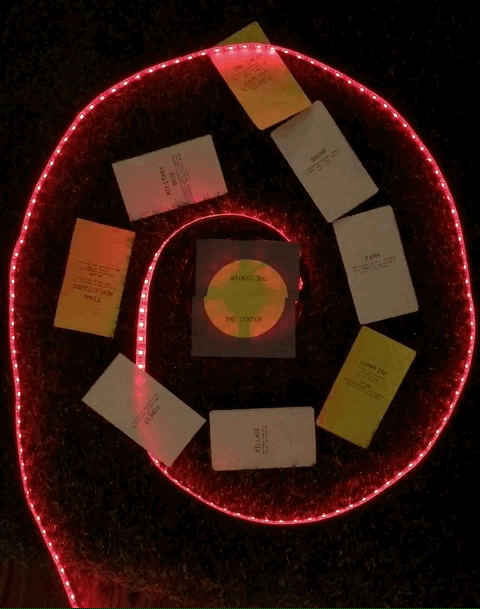
The materials around the game can help set the tone faster, making it easier for players to get into the right frame of mind. Although some of the experiments were a bit too “busy”.

It was important to embody the game’s main principle: “Campfire Stories. Controlling the lighting to create a sense of isolation and creepiness really helped.
Credit to @nickpunt for coming up with the brilliant (ha) idea of playing the game with only a flashlight for illumination. This was thematically strong, but also crucial for the usability of the game because it helped people read cards in the dim light and made crystal clear whose turn it was.
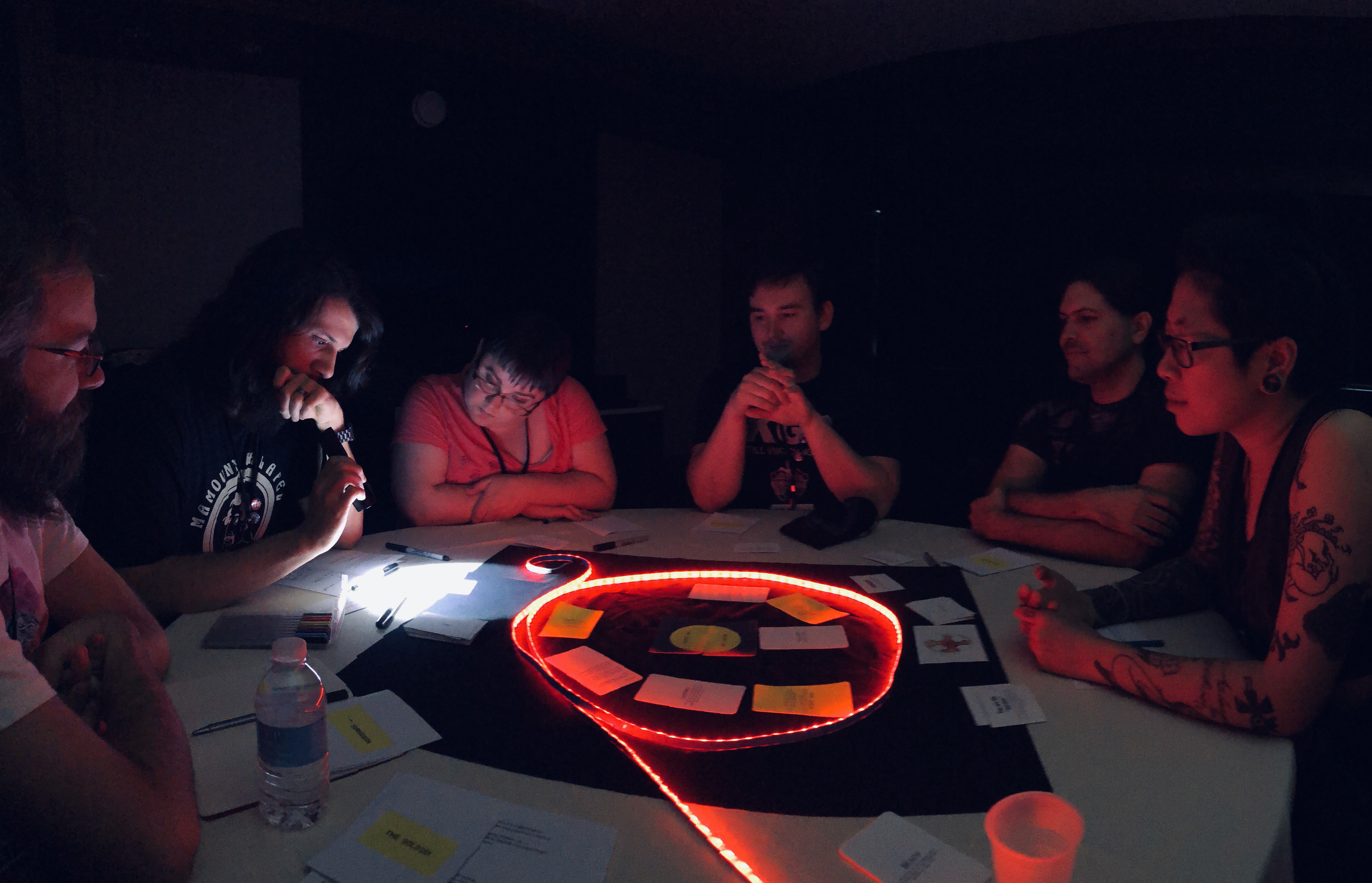
And when you’re looking at the photos above—here’s a key data point: it was 11am. 11AM, and a bright 86 degree California day outside, complete with rolling hills, blue sky, and a busy highway right outside the window of the Walnut Creek Marriott. Staging the game was crucial to transporting people away from that world, and into one of mutation, loss of humanity, and psychological horror.
So much kudos to Big Bad Con for giving all the games appropriate spaces to work in. (I’m sure the time will come where I’ll run THE ZONE in a loud convention with 300 other people in the room…)
Oh, and after hearing so much about it I just bought Stephen Dewey’s game / OG case study in how to do this (10 Candles). So excited to play it and be reduced to gibbering bolus of lonely terror! 😱
(Other recommendations welcome!)
Read More